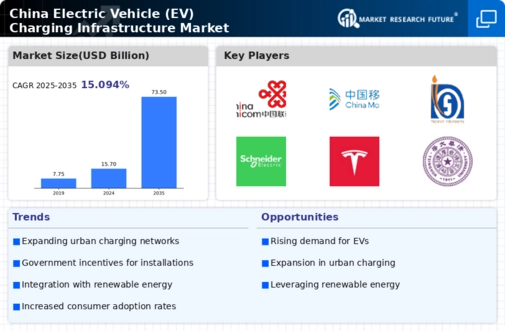-
EXECUTIVE SUMMARY
-
Market Overview
-
Key Findings
-
Market Segmentation
-
Competitive Landscape
-
Challenges and Opportunities
-
Future Outlook
-
MARKET INTRODUCTION
-
Definition
-
Scope of the study
-
Research Objective
-
Assumption
-
Limitations
-
RESEARCH METHODOLOGY
-
Overview
-
Data Mining
-
Secondary Research
-
Primary Research
-
Primary Interviews and Information Gathering Process
-
Breakdown of Primary Respondents
-
Forecasting Model
-
Market Size Estimation
-
Bottom-Up Approach
-
Top-Down Approach
-
Data Triangulation
-
Validation
-
MARKET DYNAMICS
-
Overview
-
Drivers
-
Restraints
-
Opportunities
-
MARKET FACTOR ANALYSIS
-
Value chain Analysis
-
Porter's Five Forces Analysis
-
Bargaining Power of Suppliers
-
Bargaining Power of Buyers
-
Threat of New Entrants
-
Threat of Substitutes
-
Intensity of Rivalry
-
COVID-19 Impact Analysis
-
Market Impact Analysis
-
Regional Impact
-
Opportunity and Threat Analysis
-
China Electric Vehicle (EV) Charging Infrastructure Market, BY Charger Type (USD Billion)
-
Slow Charger
-
Fast Charger
-
China Electric Vehicle (EV) Charging Infrastructure Market, BY Connector (USD Billion)
-
CHAdeMO
-
CCS
-
Others
-
China Electric Vehicle (EV) Charging Infrastructure Market, BY Level of Charging (USD Billion)
-
Level 1
-
Level 2
-
Level 3
-
China Electric Vehicle (EV) Charging Infrastructure Market, BY Connectivity (USD Billion)
-
Non-connected charging stations
-
Connected charging stations
-
China Electric Vehicle (EV) Charging Infrastructure Market, BY Application (USD Billion)
-
Commercial
-
Residential
-
Competitive Landscape
-
Overview
-
Competitive Analysis
-
Market share Analysis
-
Major Growth Strategy in the Electric Vehicle (EV) Charging Infrastructure Market
-
Competitive Benchmarking
-
Leading Players in Terms of Number of Developments in the Electric Vehicle (EV) Charging Infrastructure Market
-
Key developments and growth strategies
-
New Product Launch/Service Deployment
-
Merger & Acquisitions
-
Joint Ventures
-
Major Players Financial Matrix
-
Sales and Operating Income
-
Major Players R&D Expenditure. 2023
-
Company Profiles
-
China Unicom
-
Financial Overview
-
Products Offered
-
Key Developments
-
SWOT Analysis
-
Key Strategies
-
Shanghai Jiao Tong University
-
Financial Overview
-
Products Offered
-
Key Developments
-
SWOT Analysis
-
Key Strategies
-
China Mobile
-
Financial Overview
-
Products Offered
-
Key Developments
-
SWOT Analysis
-
Key Strategies
-
State Grid Corporation of China
-
Financial Overview
-
Products Offered
-
Key Developments
-
SWOT Analysis
-
Key Strategies
-
BYD Company
-
Financial Overview
-
Products Offered
-
Key Developments
-
SWOT Analysis
-
Key Strategies
-
Siemens AG
-
Financial Overview
-
Products Offered
-
Key Developments
-
SWOT Analysis
-
Key Strategies
-
China National Petroleum Corporation
-
Financial Overview
-
Products Offered
-
Key Developments
-
SWOT Analysis
-
Key Strategies
-
NIO Inc.
-
Financial Overview
-
Products Offered
-
Key Developments
-
SWOT Analysis
-
Key Strategies
-
Schneider Electric
-
Financial Overview
-
Products Offered
-
Key Developments
-
SWOT Analysis
-
Key Strategies
-
Xpeng Motors
-
Financial Overview
-
Products Offered
-
Key Developments
-
SWOT Analysis
-
Key Strategies
-
Wuhan Zhongwei
-
Financial Overview
-
Products Offered
-
Key Developments
-
SWOT Analysis
-
Key Strategies
-
Tesla Inc.
-
Financial Overview
-
Products Offered
-
Key Developments
-
SWOT Analysis
-
Key Strategies
-
Tsinghua University
-
Financial Overview
-
Products Offered
-
Key Developments
-
SWOT Analysis
-
Key Strategies
-
China Southern Power Grid
-
Financial Overview
-
Products Offered
-
Key Developments
-
SWOT Analysis
-
Key Strategies
-
ABB Ltd.
-
Financial Overview
-
Products Offered
-
Key Developments
-
SWOT Analysis
-
Key Strategies
-
References
-
Related Reports
-
China Electric Vehicle (EV) Charging Infrastructure Market SIZE ESTIMATES & FORECAST, BY CHARGER TYPE, 2019-2035 (USD Billions)
-
China Electric Vehicle (EV) Charging Infrastructure Market SIZE ESTIMATES & FORECAST, BY CONNECTOR, 2019-2035 (USD Billions)
-
China Electric Vehicle (EV) Charging Infrastructure Market SIZE ESTIMATES & FORECAST, BY LEVEL OF CHARGING, 2019-2035 (USD Billions)
-
China Electric Vehicle (EV) Charging Infrastructure Market SIZE ESTIMATES & FORECAST, BY CONNECTIVITY, 2019-2035 (USD Billions)
-
China Electric Vehicle (EV) Charging Infrastructure Market SIZE ESTIMATES & FORECAST, BY APPLICATION, 2019-2035 (USD Billions)
-
PRODUCT LAUNCH/PRODUCT DEVELOPMENT/APPROVAL
-
ACQUISITION/PARTNERSHIP
-
MARKET SYNOPSIS
-
CHINA ELECTRIC VEHICLE (EV) CHARGING INFRASTRUCTURE MARKET ANALYSIS BY CHARGER TYPE
-
CHINA ELECTRIC VEHICLE (EV) CHARGING INFRASTRUCTURE MARKET ANALYSIS BY CONNECTOR
-
CHINA ELECTRIC VEHICLE (EV) CHARGING INFRASTRUCTURE MARKET ANALYSIS BY LEVEL OF CHARGING
-
CHINA ELECTRIC VEHICLE (EV) CHARGING INFRASTRUCTURE MARKET ANALYSIS BY CONNECTIVITY
-
CHINA ELECTRIC VEHICLE (EV) CHARGING INFRASTRUCTURE MARKET ANALYSIS BY APPLICATION
-
KEY BUYING CRITERIA OF ELECTRIC VEHICLE (EV) CHARGING INFRASTRUCTURE MARKET
-
RESEARCH PROCESS OF MRFR
-
DRO ANALYSIS OF ELECTRIC VEHICLE (EV) CHARGING INFRASTRUCTURE MARKET
-
DRIVERS IMPACT ANALYSIS: ELECTRIC VEHICLE (EV) CHARGING INFRASTRUCTURE MARKET
-
RESTRAINTS IMPACT ANALYSIS: ELECTRIC VEHICLE (EV) CHARGING INFRASTRUCTURE MARKET
-
SUPPLY / VALUE CHAIN: ELECTRIC VEHICLE (EV) CHARGING INFRASTRUCTURE MARKET
-
ELECTRIC VEHICLE (EV) CHARGING INFRASTRUCTURE MARKET, BY CHARGER TYPE, 2025 (% SHARE)
-
ELECTRIC VEHICLE (EV) CHARGING INFRASTRUCTURE MARKET, BY CHARGER TYPE, 2019 TO 2035 (USD Billions)
-
ELECTRIC VEHICLE (EV) CHARGING INFRASTRUCTURE MARKET, BY CONNECTOR, 2025 (% SHARE)
-
ELECTRIC VEHICLE (EV) CHARGING INFRASTRUCTURE MARKET, BY CONNECTOR, 2019 TO 2035 (USD Billions)
-
ELECTRIC VEHICLE (EV) CHARGING INFRASTRUCTURE MARKET, BY LEVEL OF CHARGING, 2025 (% SHARE)
-
ELECTRIC VEHICLE (EV) CHARGING INFRASTRUCTURE MARKET, BY LEVEL OF CHARGING, 2019 TO 2035 (USD Billions)
-
ELECTRIC VEHICLE (EV) CHARGING INFRASTRUCTURE MARKET, BY CONNECTIVITY, 2025 (% SHARE)
-
ELECTRIC VEHICLE (EV) CHARGING INFRASTRUCTURE MARKET, BY CONNECTIVITY, 2019 TO 2035 (USD Billions)
-
ELECTRIC VEHICLE (EV) CHARGING INFRASTRUCTURE MARKET, BY APPLICATION, 2025 (% SHARE)
-
ELECTRIC VEHICLE (EV) CHARGING INFRASTRUCTURE MARKET, BY APPLICATION, 2019 TO 2035 (USD Billions)
-
BENCHMARKING OF MAJOR COMPETITORS








